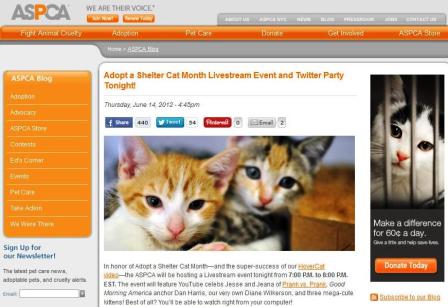Social 'petworking' gives homeless animals a million more chances at adoption
You can’t visit every animal shelter in the country to find your furry new BFF, but you can scroll through Facebook or Flickr from your home computer. It’s as comfortable as online dating and as convenient as “Add to Cart.” Social media has forever transformed the process of adopting pets.
From the early days of mass emails about kittens available to a good home, the Internet and social media particularly have become essential tools for rescue organizations trying to reach every possible adopter — especially for pets needing extra help to find that special someone.
“We use Facebook for everything — fundraising, sharing our adoptable dogs, sharing our wonderful, successful adoption stories, ‘happy tails,’ and just general news,” said Angela Stell, director and founder of New Mexico Dogs Deserve Better (NMDDB). The two-year-old group has never operated without social media.
Animal Humane New Mexico, at 47 years old, also does not hesitate to keep up with the times. Its photos, videos, and stories of available pets receive dozens, sometimes hundreds, of comments, “shares,” and “likes,” leading to many successful adoptions.
“We needed to share stories that would touch people’s hearts, because they’re more likely to ‘share’ that story,” said Dawn Glass, marketing director at Animal Humane. “And that’s how we’re able to find homes for pets.”

Recently a neglected young dog was brought to Animal Humane. Wrigley was shy and fearful, but improved greatly as the shelter’s behavioral team worked with him. “He needed an owner who would understand his needs,” said Glass. “That’s not an everyday adopter.”
Wrigley’s photo and story were posted on Facebook and received 130 “shares” in the first few hours. He was quickly adopted by an experienced dog owner who saw the post in a friend’s newsfeed. The combination of photo and story is powerful: It takes the idea of adopting a dog or cat and personalizes it. You read the animal’s history and see something of its character.
Recently the NMDDB shelter in Hobbs posted a photo and story on the group’s Facebook page about a tripawd (three-legged) Husky in need of a home. The post was seen by a woman in Georgia who fell in love instantly. NMDDB made arrangements for a home visit, screening, and safe places for the dog to stay on her journey.
“Using these social media sites opens up all sorts of new doors to opportunities that the dogs did not have before,” said Stell. “But with that also comes a downside: More people with ill intentions, or those that really have no business having an animal, also have access to the information.” That makes due diligence even more important in placing animals in the Internet age. NMDDB uses an intensive screening process on all placements, Stell said, as well as for transport drivers and other volunteers. “You can never be too careful when lives are at stake.”
Online shoppers learned long ago to be careful about using Craigslist. That caution holds doubly true for animals offered on the want-ad site. One rescuer in Albuquerque contacted what appeared to be a fellow rescuer on Craigslist, only to discover that he was a front for an illegal breeding operation. She asked not to be identified in this story because of deadly threats the breeder made when she confronted him.
Thanks for sharing
Social media operates much like word of mouth, multiplied by thousands. “Sharing” on Facebook can make any post snowball, extending to new networks and audiences. Sam Blankenship, director of adoptions at Animal Humane, said each time one of their “Pet Tail” videos is posted, the featured dog — usually one that has languished at the shelter for months — is adopted within three weeks.
“We use photos on Facebook and Twitter to help animals, asking our friends to share the videos and photos so we can flood the web with the animal in need,” he said. “We are batting 100 percent with our adoption videos. Social media has changed the face of adoptions.”
Animal Humane joined Facebook in 2009, but didn’t start using it seriously until 2010, said marketing director Glass. “As we realized the importance of social media, we became more formal and strategic in our content, so that we have a consistent voice and message to our community and can be sure that every post we make is going to be really effective.”
Joining YouTube in 2010, Animal Humane began posting videos to introduce adoptable pets, and featuring a “senior pet of the week.” The film team is made up of four members of the adoptions staff who take turns writing and filming videos about animals that have been in the shelter for more than 70 days. Soon they plan to expand that to pets who’ve been waiting more than 30 days.
The staff uses Flickr to archive pet photos and event photography, and Twitter to keep followers updated on where the mobile adoption team will be. “A lot of people will re-tweet,” said Glass, “and that helps direct traffic to our local adoptions.”

The national ASPCA (American Society for the Prevention of Cruelty to Animals) used Twitter to help animals find homes after a tornado hit Joplin, Miss., last year. In June the group launched a campaign to make pet adoption “go viral,” live-streaming programs from headquarters in New York City. Now ASPCA is using Facebook, Twitter, and Pinterest to boost hard-to-adopt cases, and with its national audience has been finding people willing to travel across the country to rescue previously unwanted pets.
Spreading the love
People share information online for the same reasons they did before the Internet — because they feel a personal stake in the information and want others to know about it. With a single post, tweet, or uploaded video instantly executed on a smartphone, that impulse can reach across the country in minutes, with unexpected results. That’s what makes social media such a valuable tool in pet adoption: It’s quick, convenient, far-reaching but also targeted.

Fans who “like” the Facebook page of a particular shelter stay apprised of its events and needs, building an audience of supporters. But those hard-core fans also have friends, connections, and interests beyond the rescue community, just a post away, multiplying their reach.
Informal emailing is still widely used among friends to get animals adopted or reunite them with their owners (see “Email trail ends in happy tail,” opposite). But on social media, the positive impact doesn’t have to end with adoption. “Tell your friends one of the most effective ways you can help animals,” said Glass, “is by sharing your positive adoption experience on Facebook, and helping us spread the word.” And you can re-post that all you want.
Animal Humane volunteers Patti Danforth and Pam Nichols work on a video featuring an adoptable dog. Photo courtesy Animal Humane.
Email trail ends in happy tail
Apparently, it happened like this: A photo of a dog was sent June 28 from Angela to Julie, who sent it to Barb, Bonita, and Mateo. Barb then sent it to her email list with a message that read, in part, “My friend Julie was in Annapurna restaurant a few days ago, when this puppy wandered in and layed down on her feet. It has no tags, no microchip, no lost dog signs around, no calls to the pound looking for it. She’s female, very sweet, and about 4 months old. My friend is going to Mexico for two-weeks starting this Sunday and is desperately trying to find someone to either foster care for it or adopt it forever...”
I forwarded the email to a rescuer in Los Lunas named Viola who has a large email list often used to find dogs homes.
The next day, Sandi responded to Viola’s email. “I know who’s been looking for that pup! She escaped from her yard!”
The puppy’s owners drove up to Bernalillo to fetch their dog that very afternoon, leading Julie to send a final email: “this is one heck of a happy story — although my throat was a bit choked up saying goodbye — but what a crazy reunion it was — the owner had given up hope and had built a shrine for the pup...,” which naturally led to highfives all around the list.
In another era, that puppy might not ever have found its way back home, and ended up instead in the shelter/foster system. A few casually circulated emails reunited this dog with the owners in two days. — Editor
